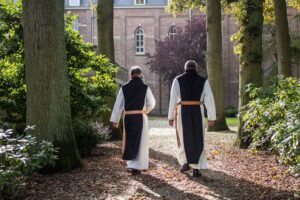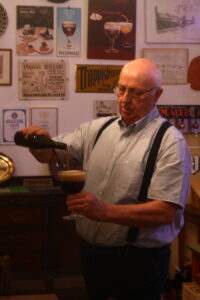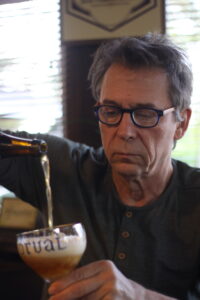

In the old days, when animals still spoke, Trappist (with a lower case letter), like stella, was a pars pro toto or a brand name used as a generic term - think also of bic, kleenex and spa, among others. Anyone ordering a stella in a pub meant a pint. While a trappist meant as much as a heavy dark beer, which elderly ladies consistently desecrated with a splash of grenadine. But times have changed. Today, the term "Trappist" is primarily associated with authenticity, craftsmanship, integrity, tradition and mysticism.


According to the late Michael Jackson (who died in 2007), the British namesake of the King of Pop, who died two years later, Trappist beers are not a separate style, but a recognisable family with a number of common traits. Jackson distinguished mostly heavy beers of high fermentation, with refermentation in the bottle and a fruity taste. Usually dark in colour and relatively sweet, often the result of adding dark candy sugar, which gives them a distinctive rum-like flavour, according to Jackson. He suspected that most Trappist beers owe their complex flavour to high-temperature fermentation. He also surmised that because the Trappist order is the world's strictest and most closed monastic order, its brewing traditions are scrupulously maintained.
Jackson made the above analysis over twenty years ago, when Trappist was still almost exclusively a Belgian affair. In the meantime, various foreign Trappist beers have come onto the market. Most of them, but not all, bear the ATP logo - ATP stands for ''Authentic Trappist Product''. In any case, this has only increased the differences between them. In this country, too, the Trappists began to diversify, for example the beers that were originally only drunk by the monks at the table, such as Chimay Goud and Westmalle Extra. They are blond, light, fresh and uncomplicated, exactly the opposite of what Michael Jackson understood by 'Trappist'.


On the other hand, Trappist beers enjoy more than ever an unassailable reputation in the international beer world. Beer that is brewed behind monastery walls, where no or very few visitors are allowed, naturally stimulates the imagination, fuels speculation and sets the rumour mill spinning. No wonder that Trappist beer has increasingly acquired mythical status over the years. The front runner in this respect is Westvleteren, probably the most mysterious and most sought-after beer under the sun. High time to separate the facts from the myths about the world-famous Trappist beer, from a godforsaken corner of Belgium.
Discontent in Westmalle
What happened before. In the summer of 1831, the prior and three monks of the Franco-Flemish Trappist monastery Mont des Cats crossed the border and travelled to the Kerselaarsbos in Westvleteren, situated fifteen kilometres from Katsberg. There they joined Joannes Baptista Victoor, a hop merchant from Poperinge who had lived there as a hermit for seventeen years and died the following year. His hermitage was converted into Westvleteren Priory, which was to become an abbey in 1871. The clergymen worked the surrounding fields and made cheese to support themselves. In 1839, three years after the monastery came under the jurisdiction of Westmalle Abbey, King Leopold I signed a brewing licence for Westvleteren, and a few months later brewing began officially for the first time, but only for his own use. From 1877, beer production became one of the economic activities of the abbey. Even more so: in the 1930s, beer merchants in West Flanders and even beyond were supplied by lorries. Meanwhile, four different beers were brewed in St Sixtus Abbey: the then refectory beer Ordinaire (2°), Double (4°), Spécial (6°) and Extra (8°). It was only in 1940, at the beginning of the Second World War, that Westvleteren 12° was brewed for the first time.

After the war, in 1945, Dom Gerardus Deleye, abbot of St Sixtus Abbey, made a drastic decision that would eventually lead to an unprecedented international hype. The production of the brewery was limited to the amount that was necessary to support himself. Westvleteren was only brewed for the nearby inn In De Vrede, owned by the fathers, and for three monastic communities connected to the abbey, such as Sacré-Coeur in Poperinge. Any surpluses were sold to private individuals at the abbey gate. Moreover, the bottles were no longer labelled. Logic itself, given the abandonment of commercial purposes, but unintentionally and ironically one of the factors that would later blow the worldwide cult around Westvleteren out of proportion. A marketing genius could not have thought of it better.


The monks took care of all the brewing activities since 1945. The lay employees were thanked without mercy for their services. Among them was the Polish brewmaster Mathieu Szafranski, who had moved to Belgium in 1929 and had started working at St. Sixtus Abbey four years later. Abbot Gerardus' surprising switch was by no means appreciated in the Trappist community, not least in Westmalle. People there were afraid that the West Flanders abbey would suffer financially. Bearing in mind the obligation of solidarity among Trappist monasteries, colleagues should come to the rescue in such cases. And that was not so obvious just after the war.
A sour beer
After this alarm signal, Westvleteren started thinking about possible outside income. And they found the following: in 1946, a licence agreement for the production and commercialisation of their Trappist beer was concluded with Evariste Deconinck, a good friend of abbot Gerardus, but strangely enough not a brewer himself. The price tag of the licence was nevertheless worth it: 2 million Belgian francs and, on top of that, annual royalties of 5,000 francs, payable to St Sixtus Abbey. Deconinck owned a cheese factory in Watou, more specifically on the site of the castle farm Refuge Notre-Dame de Saint-Bernard. Monks from - again - Mont des Cats had bought this farm at the beginning of the last century after they had fled their country, where anticlericalism was rampant. They made cheese there that turned out to be similar to Port Salut. In 1934, when the French government's attitude towards the Church had become milder, the monks sold their refuge and returned to the abbey on the Katsberg, where similar Trappist cheese is still made today.


Evariste Deconinck, for his part, apparently realised that there was a lot of money to be made with the Trappist beer of Westvleteren. As a result, he had a brewery built next to his cheese dairy: Brasserie Saint-Bernard. Two thirds of the shares were divided with his brother Antoine, one third went to Mathieu Szafranski, who was included as a third partner in order to contribute his expertise. Szafranski brought along not only his know-how, but also the recipes of the Westvleteren beers, while some 25 wooden barrels were taken over from Saint Sixtus Abbey - but not the brewing installation or part of it, as is sometimes suggested, and certainly not Westvleteren's own yeast (about which more later).
Inevitably, we come to the question about which lots of ink has already been spilled. Is St. Bernardus Abt 12, which is brewed in Watou and was put on the market 75 years ago (alternately as St. Sixtus Abbey and as Trappist beer Westvleteren), identical to Westvleteren 12? It is not excluded that both beers were initially brewed to the same recipe, certainly in view of the transfer of Szafranski, but we will never have 100 percent certainty about this. Both breweries initially used groundwater that probably came from the same water layer. Naturally, two different brewing installations were used, although both were probably just as old-fashioned - dating from the beginning of the last century. The fact is that Westvleteren 12°, as it was brewed for a quarter of a century from 1940 onwards, tasted completely different from the current one; it was more like old brown. The Westvleteren monks used an open cooler, which resulted in a sour beer. And they were not too happy with that. To camouflage the sour taste, the beer was sweetened with saccharin.

urban legend
In the early seventies, the lay employee, who worked as a driver delivering to external customers in the surrounding area, repeatedly returned to St Sixtus Abbey with more beer than he had left with in the morning. What was going on? It turned out that disgruntled customers were returning the Trappist of Westvleteren because its quality left something to be desired. Since the brewery was cleaned but not disinfected at the time, and the beer was stored in wooden barrels, it probably became infected. It was not until the mid-1970s that help was sought from other Trappist abbeys, first from a brother brewer in Chimay and then from Brother Thomas Sas, who was responsible for the beer production in Westmalle. Brother Thomas informed the worried monks that only minor adjustments were necessary, but then not only removed the brewing errors from the production process, but also changed the entire recipe. From 1976, the open cooling vessel was no longer used to cool the wort; since then, this has been done in a closed wort cooler. In addition, a fermentation room with six open stainless steel tanks was built. Finally, only liquid yeast from the Westmalle Trappist brewery was used in the brewing process.

That St. Bernardus Abt 12 is still brewed today according to the same recipe as in olden days and with the original St. Sixtus yeast, is a persistent myth. Let us go back to 1942 for a moment. Many breweries in the region were in trouble at the time. Raw materials were becoming increasingly scarce. The Westvleteren monks could only brew once every three weeks - some months not at all. That was certainly not enough to keep their own yeast alive. In order to bridge the periods of non-brewing, local brewers agreed to borrow yeast from each other. After the war, the brewery of Sint-Sixtus used alternately yeast from certain West Flemish breweries and other Trappist breweries, but also self-harvested yeast. It went like this. While the wort cooled down in the brewery's cooling vessel, wild yeasts got into the brewage. They were used in the next brew, together with the yeast that was harvested in the fermentation room. In short: pure Saint Sixtus yeast has almost certainly never existed.

Significant difference
All well and good, but what is the crucial difference between both beers? For starters, in 1992, the brewing licence of St. Bernard came to an end, as a result of which Westvleteren is still only brewed in St. Sixtus Abbey. But long before that, the brewing process in Watou differed from that in Westvleteren in many ways. For example, St. Bernardus Abt 12 is centrifuged and Westvleteren 12 is not. Moreover, the main fermentation of the former takes place in closed fermentation tanks, whereas the main fermentation of the latter takes place in open fermentation vats - albeit for the past ten years or so in a closed space where only filtered air can enter. Because of the fermentation in open fermentation tanks, more esters manifest themselves, which makes Westvleteren slightly fruitier.


On the other hand, when brewing St. Bernardus, roasted malt is used, whereas Westvleteren is exclusively brewed with pale malt. The dark colour of the leading Trappist beer is only due to the use of candy syrup, which, incidentally, was already added before WW II. Until 1946, the abbey brewed with Kenya malt and Fuggles hops. Due to reduced production, the surplus of malt and hops was also transferred to St. Bernardus in that year. Today, neither brewery uses these raw materials anymore. St.Bernardus is brewed with two home-grown hop varieties: Hallertau Magnum and Kent Golding. For Westvleteren, Poperinge hop pellets and hop extract are used (until the end of the fifties, these were hops grown on the abbey farm). Furthermore, Watou still brews with well water, whereas Saint Sixtus Abbey has switched to tap water. Finally, the yeast used to brew both beers differs: own yeast for St. Bernardus, Westmalle yeast for Westvleteren. Without a doubt, all this leads to small, sometimes almost imperceptible differences, which together probably make a significant difference.
Exorbitant prices
In 2001, in the revised edition of his standard work Great Belgian Beers, Michael Jackson drew the world's attention to the attraction of the mysterious abbey in the Westhoek: 'The most difficult trappist beers to find are those of Westvleteren. There is no distribution. Pub owners and shopkeepers have to go and get their beer - and it is rationed.' And then comes a passage that sticks in the collective memory: 'Anyone calling the abbey is told by a recorded message which beer is available at that moment. If it is the 12°, then the cars are lined up long before the opening time. And again, no publicity campaign could have beat this. The magic word? Scarcity.

Imagine: a beer that you can only buy at the abbey gate. And of which the fathers only want to brew six thousand hectolitres a year. No matter how much people scream for more. And it is a very good beer too. So says Jackson. In 2002, Ratebeer elected Westvleteren as the best brewery in the world and three years later, the sky was the limit: Westvleteren 12 climbed to the first place of the international ranking of the best beers. The beer, which was already extremely hard to come by, immediately acquired an almost otherworldly aura. Demand increasingly exceeded supply. From far and near, beer lovers travelled to Westvleteren in the hope of getting their hands on a case of the best beer in the world. The kilometres of traffic jams on the rural roads around the abbey made it difficult for the farmers in the neighbourhood to reach their fields. A telephone reservation system was introduced, but the busy signal at the other end of this beer phone was the rule rather than the exception. Despite (or precisely because of) the explicit prohibition on reselling, Westvleteren 12 was increasingly being chased down at exorbitant prices - up to three hundred dollars for a bottle.

The alarm bells rang deafeningly loud within the monastery walls when in March 2018 it emerged that the Dutch supermarket chain Jan Linders was offering the world's most coveted beer for sale at 9.95 euros a bottle - four times the selling price you paid for it at the abbey gate - and allegedly had no less than three hundred cases or 7,200 bottles of it in stock. The fathers no longer allowed this "consumer fraud" to go unchallenged. According to them, dishonest traffickers played the role of middlemen, which led to a flourishing black market. To put a stop to this, they started thinking about a new ordering system.

Delivered to your door

In the summer of 2019, the time had come. At a well-attended press conference in Ontmoetingscentrum In De Vrede, Dom Manu Van Hecke, current abbot of St Sixtus Abbey, announced that sales would be organised differently. Exit beer phone (which was largely monopolised by professional buyers), enter web shop via the site www.trappistwestvleteren.be. Lovers must first register and then have the choice between the three types of Westvleteren: Blond, 8 and 12. A maximum of two crates of these are available per purchase. Although sales at the abbey gate remain by far the most important distribution channel, since the beginning of 2021 and under the motto 'necessity breaks the law' a small portion of the most coveted beer on this planet is actually delivered at home, albeit in cardboard packaging, so not in the iconic poplar crate. But not too early to cheer. There are a lot of people waiting for you.
Yet! In order to meet the ever-growing demand from all corners of the world, the possible solution is as simple as bonjour: increase production. But the Fathers don't want to know about that. They have considered the problem repeatedly, says Father Abbot. However, their motto remains unchanged until further notice: 'We brew to live, we do not live to brew.' In other words, brewing is secondary to the reclusive monastic life of rest and contemplation, where the monks divide their time between prayer, reflection and work. That is why annual production is limited to about six thousand hectolitres, spread over some forty brewing days a year. The profits are used solely for the livelihood of the monks and the maintenance of the monastery. What is left over goes to development projects and social causes. The fact that the Cistercians, as virtuous as they are silent, are not consistent is the last thing you can accuse them of.
Wim Swinnen
We are happy to share our adventure in the Trappist world. Stay tuned for our exclusive anecdotes, facts and novelties.


